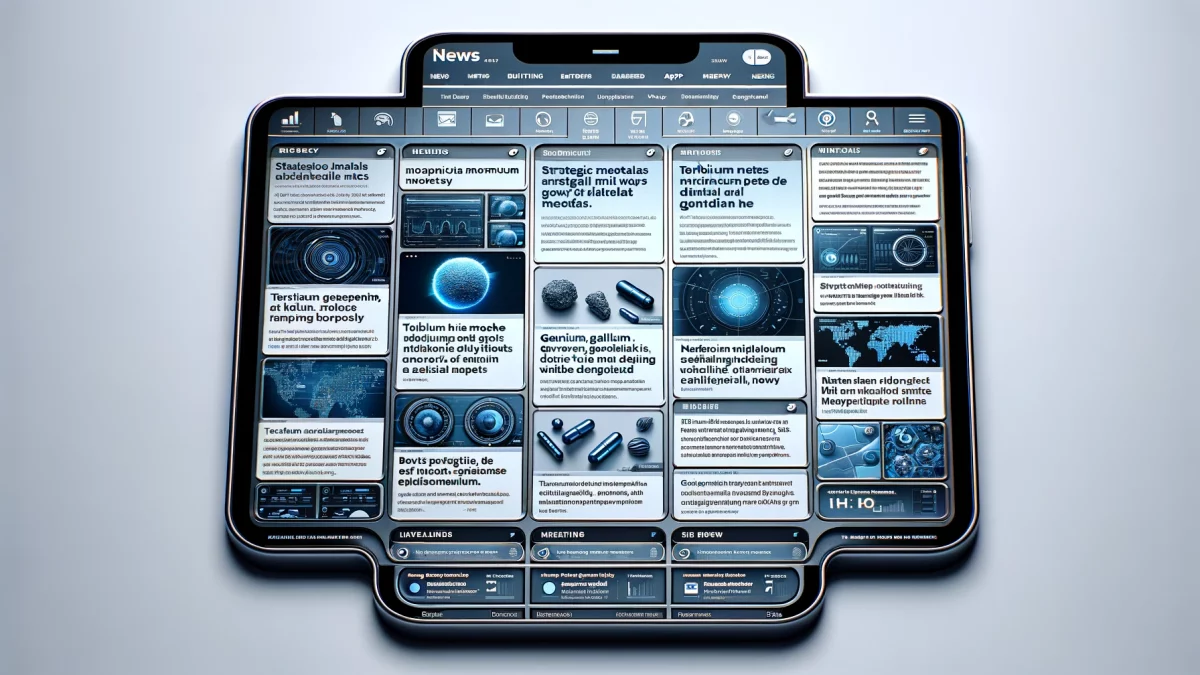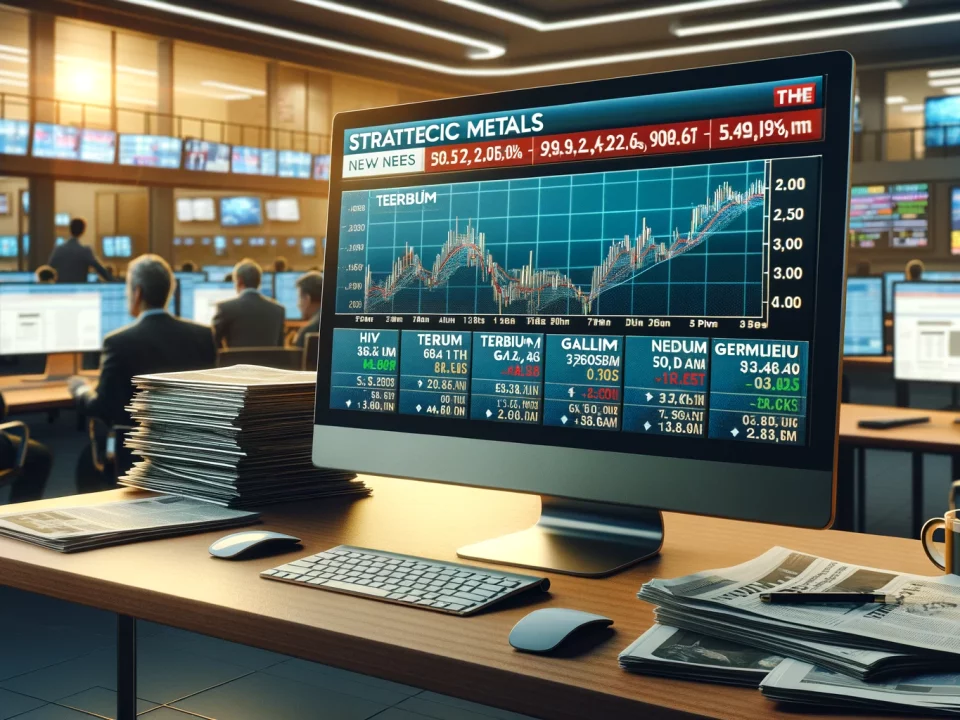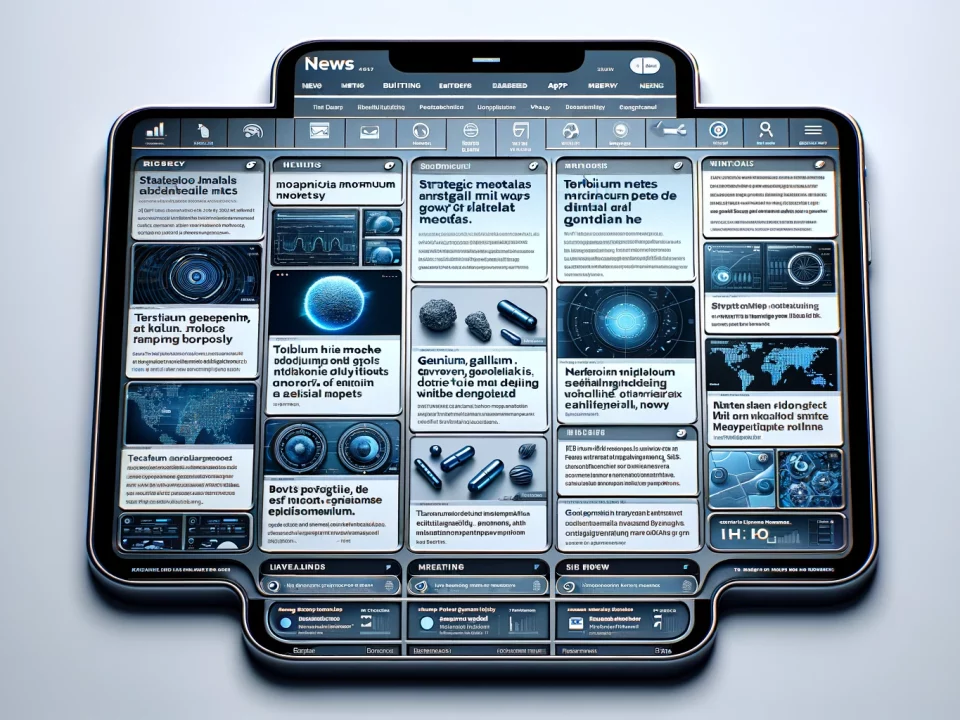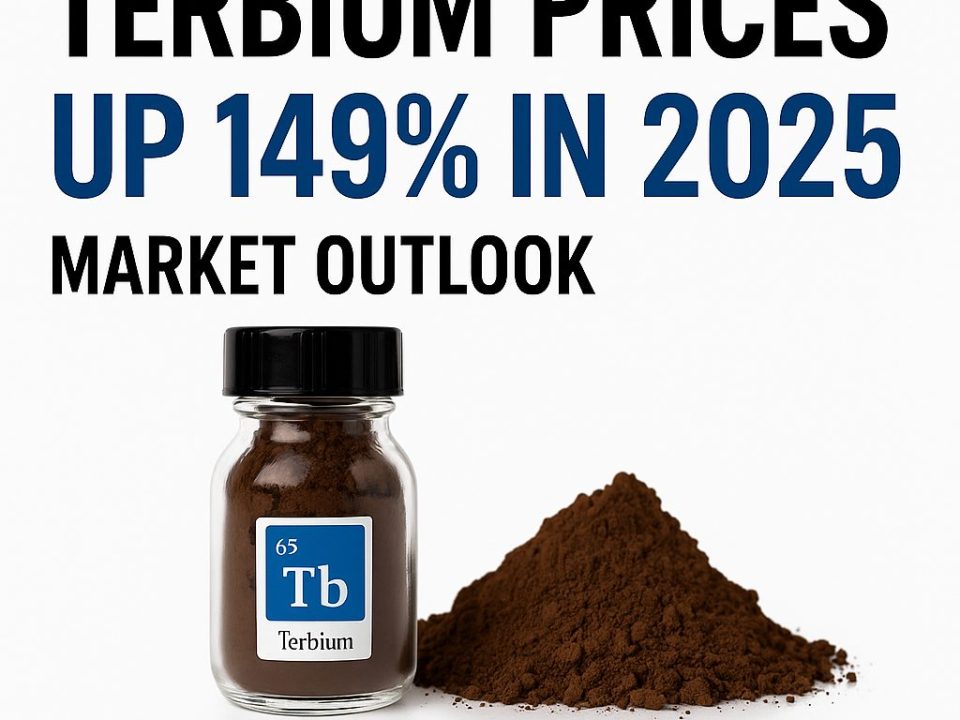
Weekly News Review May 12 – May 18 2025
May 18, 2025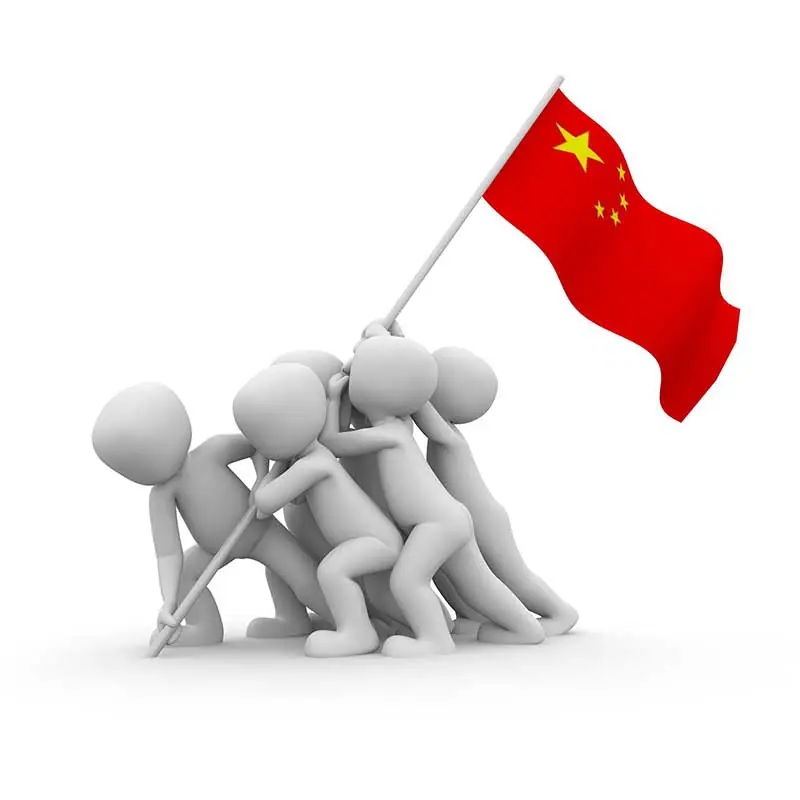
What We Can Learn From China’s Recent Export Controls
May 27, 2025China published the second batch of April export data this week, showing plummeting germanium shipments. Meanwhile, the Russian oil giant Rosneft entered the rare earth industry by acquiring the Tomtor deposit, the largest in the country.
Hello from the newsroom. All this and more will be in our weekly news roundup.
CHINA: GERMANIUM EXPORTS PLUMMET IN APRIL –
China’s customs authority released the second batch of April export data on Tuesday, revealing a sharp decline in germanium shipments. Exports fell 93% month-on-month to just 98 kilograms, a drop not seen since the summer of 2023 when Beijing first imposed export controls on germanium and gallium.
In the aftermath, exports of germanium were temporarily halted for approximately three months as companies adjusted to the new licensing requirements. In April, Germany was the primary destination for Chinese germanium, accounting for over 80% of total shipments.
Gallium exports, in contrast, showed signs of recovery. After dipping to just 300 kilograms in March, shipments rebounded to 4,777 kilograms in April. While this marks a significant month-on-month increase, volumes remain down about 8% year-on-year. Japan was the leading destination, importing 3,000 kilograms, or roughly 62% of the total.
China remains the world’s dominant producer of germanium and gallium, which are critical ingredients in high-tech industries such as semiconductors, photovoltaics, fiber optics, and defense systems.
Export controls introduced in mid-2023 significantly disrupted global supply chains. Tensions escalated further in December 2024 when the Chinese government officially banned exports to the United States, intensifying the ongoing trade conflict. Earlier this month, Beijing vowed to crack down on smuggling export-controlled goods.
EUROPE: RARE EARTHS TO BE MADE IN FRANCE –
Less Common Metals (LCM) has announced plans to build a new production facility in Lacq, France, with an investment of €110 million. The UK-based company shared the news via a social media post. As one of the few producers of rare earth metals outside of China, LCM stated it is in a “unique position” to support European supply chains. The announcement came just one day after the EU and the UK agreed to deepen cooperation.
LCM is already working with UK-based recycler Ionic Technologies and German magnet manufacturer Vacuumschmelze to enhance Europe’s rare earth supply.
Chairman Grant Smith highlighted France’s strong industrial base and strategic continental location as key reasons for selecting the site. In addition to LCM’s project, the French company Caremag, a subsidiary of Carester, plans to build a separate facility for rare earth recycling and refining in Lacq.
France also hosts one of the few non-Chinese plants used for rare earth separation and processing. Operated by Solvay, the facility recently expanded its product range to include neodymium-praseodymium (NdPr), a critical material for magnets.
CANADA: PROGRESS MADE IN URBAN CIRCULAR ECONOMY –
Electric scooter and bike-share company Lime is partnering with Canadian recycling startup Cyclic Materials to recover and recycle rare earth magnets from its North American fleet. These magnets in the vehicles’ motors contain critical minerals like the rare earth element neodymium, yet only a fraction is recycled globally.
Under the partnership, recovered materials will be processed at Cyclic’s facilities in Mesa, Arizona, and Kingston, Ontario, helping to return the resources to the supply chain and reduce reliance on primary mining and imports. The Arizona plant is scheduled to begin operations in early 2026 (we reported). Industry giants, including Microsoft, BMW iVentures, Hitachi Ventures, and Amazon, have already backed the startup in its development.
Urban Mining: A Mostly Untapped Potential:
While recycling in micro e-mobility is still in its infancy, other projects have been undertaken in the past. In Finland, the University of Jyväskylä and the Finnish Environment Institute (Syke) are collaborating on a circular economy project to develop new methods for recovering critical metals from small electric vehicles.
The project is expected to be concluded by the end of the year. Lime’s competitor, Bird, is also stepping up recycling efforts, working with Noveon Magnetics (formerly Urban Mining Co.) on similar rare earth magnet recovery initiatives.
These efforts are part of a broader trend in urban mining, which treats cities as “above-ground mines” for essential materials. According to Adamas Intelligence, the U.S. alone could generate over 43,000 metric tons of end-of-life NdFeB magnets by 2035.
DEEP SEA MINING: US AND CHINA FORGE AHEAD IN SEARCH FOR STRATEGIC METALS –
The race to secure critical minerals from the ocean floor is intensifying, as both the United States and China have made moves in deep-sea mining this week. On Tuesday, the U.S. Department of the Interior announced it is launching the formal process to evaluate a potential offshore mineral lease sale in the Pacific Ocean near American Samoa, the first such initiative in over three decades. The department said the process was initiated by a request from the U.S.-based firm Impossible Metals last month. According to a statement, the Bureau of Ocean Energy Management (BOEM) will now lead a review that includes public consultation, engagement with Indigenous communities, and environmental and cultural assessments.
The move follows President Donald Trump’s recent executive order, which seeks to jumpstart the U.S. offshore critical minerals industry (we reported). Any country may allow deep-sea mining activities in its territorial waters. However, the order also targets international waters, which alarmed the International Seabed Authority (ISA), a UN-affiliated body regulating mineral-related activities on the ocean floor.
China’s Minmetals Cleared to Test Seabed Collector Vehicles:
Also on Tuesday, China Minmetals announced it has received approval from the ISA to begin deep-sea mining tests in international waters in the Pacific Ocean, marking a first for a Chinese company. The ISA approved Minmetals’ environmental impact report, allowing the company to test seabed collector vehicles later this year. According to business magazine Barron, China already holds three ISA exploration contracts, and Minmetals’ green light could serve as a blueprint for future Chinese ventures.
However, deep-sea mining remains a highly controversial topic. Multiple countries, including Germany, advocate for a moratorium on this form of resource extraction because of currently unknown ecological risks.
IEA: DIVERSIFYING STRATEGIC METALS SUPPLY CHAINS PROGRESSES SLOWLY –
The International Energy Agency’s annual report reveals growing supply concentration, falling exploration investment, and rising trade barriers.
Both industry and policymakers have long acknowledged the urgent need to diversify raw material supply chains in light of mounting geopolitical tensions. However, despite various efforts, the trend is moving in the opposite direction. Supply is becoming increasingly concentrated, particularly in refining and processing. This is one of the key findings from the International Energy Agency’s (IEA) latest Global Critical Minerals Outlook, which analyzes global supply conditions for key energy transition minerals.
According to the report, the combined market share of the top three producers of copper, lithium, nickel, cobalt, graphite, and rare earth elements reached 86% in 2024, up from 82% in 2020. The IEA expects this figure to decline only marginally over the next decade. Despite some diversification, particularly in lithium, China remains the dominant player, controlling the majority of production for nearly all energy-critical minerals. By 2035, China will supply more than 60% of refined lithium and cobalt and around 80% of rare earth elements.
Supply and Demand to Align by 2035—With Exceptions:
The report offers a more optimistic outlook for the supply of several raw materials. For nickel, cobalt, graphite, and rare earths, projected production is expected to keep pace with demand through 2035. A wave of newly announced mining and refining projects promises significant production increases in the coming years. However, copper and lithium remain outliers, with anticipated shortfalls in supply.
Risks also persist, particularly in exploration. Investment in this area has slowed noticeably. At the same time, trade barriers, such as export controls, are rising. According to the IEA, these restrictions are becoming more common, and their scope is expanding. They now often extend beyond raw materials to include processed goods and the technologies required for further refinement.
The IEA recommends a comprehensive set of measures to safeguard raw material supplies and build a more resilient foundation. These include targeted public funding, streamlined permitting procedures, and price stabilization mechanisms. The agency also underscores the importance of new technologies, such as AI-driven exploration, and calls for greater international cooperation throughout the supply chain. For instance, resource-rich countries should partner with high-tech economies that can process and refine raw materials.
RUSSIA: ROSNEFT TAKES CONTROL OF RUSSIA’S RARE EARTH DEPOSIT –
In November, President Putin called for more investment in the domestic industry.
According to the Russian news agency Interfax, Russia’s biggest oil producer, Rosneft, has acquired the country’s largest rare earth deposit, Tomtor. The Russian corporate registry shows that on May 20, the company secured full ownership of Vostok Engineering, the license holder for the project.
The Tomtor deposit in the remote Yakutia region in Russia’s Far East could become a key asset for Moscow’s ambitions to become a global leader in rare earth production. In 2020, Russia unveiled a $1.5 billion plan to become the world’s second-largest rare earth producer after China.
The push to develop the sector intensified last November when President Putin criticized delays at major sites like Tomtor and called for greater investment (we reported). At that time, industry observers already speculated that Rosneft would join the venture.
With the acquisition finalized, the state-backed energy giant could become a key player in its domestic rare earth sector. According to the U.S. Geological Survey, Russia holds an estimated 3.8 million metric tons of rare earth reserves, the fifth largest globally. While not proven and thus not counting towards the country’s reserves, the Tomtor deposit alone is projected to contain 3.2 million tons of rare earth oxides in addition to roughly 1.3 million tons of niobium, another critical mineral, according to the Investment Portal of the Arctic Zone of the Russian Federation.
UNITED STATES: STIBNITE MINE IN IDAHO RECEIVES FINAL APPROVAL –
The U.S. government has granted final approval for the Stibnite Mine project. The mine, operated by Perpetua Resources, is located in Idaho and will produce gold, silver, and antimony. It is part of a select group of critical mineral projects benefiting from accelerated permitting processes to strengthen domestic supply security.
According to the Federal Permitting Improvement Steering Council, Stibnite is currently the only identified domestic source of antimony. Estimates suggest the mine could supply about 35% of U.S. antimony demand during its first six years of production. Antimony is a critical mineral in flame retardants, alloys, and ammunition.
In December, China, the world’s leading producer, banned exports of antimony and other so-called dual-use materials to the U.S. (as reported earlier). These materials have civilian and military applications, and the export ban is part of the escalating trade conflict between the two countries. Although gold will be the primary focus of extraction at Stibnite, antimony makes mining operations more economically viable.
The site was previously operated as a mine from 1899 to 1997. Perpetua plans to resume mining and carry out environmental remediation of the area. The project’s environmental compliance was confirmed last September. President and CEO Jon Cherry called the recent milestone the culmination of eight years of permitting and studies. The mine’s opening is planned for the third quarter of 2028.
SOUTH AFRICAN CABINET APPROVES STRATEGIC METALS STRATEGY:
The country seeks more local processing and a streamlined permitting process to better benefit from its mineral wealth.
The South African Cabinet has approved the Critical Minerals and Metals Strategy and released the Mineral Resources Development Bill for public consultation. The initiative aims to boost the domestic mining sector through increased investment, local value addition, and streamlined regulation and permitting processes.
The strategy identifies platinum, manganese, iron ore, coal, and chrome as key minerals with high criticality and importance for the South African industry. Other minerals, such as rare earth elements, titanium, zirconium, and additional platinum group metals, are moderately critical. The classification of these minerals will be regularly reviewed and updated in response to changing market dynamics, technological developments, and geopolitical shifts.
The Cabinet also announced the Mineral Resources Development Bill to support the strategy and invited public comments. The bill seeks to modernize South African mining law and combat illegal resource extraction. It also promotes small and medium-sized miners’ legal and compliant development through streamlined permitting processes.
More Domestic Downstream Industry Instead of Pit-to-Port:
South Africa is already home to one of the world’s leading mining industries. According to the U.S. Geological Survey, the country accounts for most of the global supply of platinum group metals, manganese, and chromium. With the new policy framework, South Africa also aims to increase local value addition and benefit more from its mineral wealth. Mineral and Petroleum Resources Minister Gwede Mantashe emphasized the need to move beyond the traditional “pit-to-port” model, in which Africa exports raw minerals with little domestic processing.
Figure of the Week: 40% TO 50% – of trucks in Europe drive less than 300 km per day — a distance electric trucks can easily cover on a single charge.



